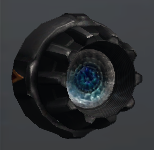Jet engine
A jet engine is an air-breathing engine which uses onboard liquid fuel and combusts it with the oxygen drawn from the atmosphere. Due to the lower air pressure at higher altitudes its thrust output varies accordingly.
Usage
Unlike rocket engines, a jet draws oxygen from the atmosphere rather than taking it from an on-board tank. This is represented in-game by a much lower rate of fuel consumption. Depending on the aircraft, jet engines can produce thrust at altitudes greater than 20 km. Jet engines do not perform in the same manner as rocket engines. Since Jet engines rely on a turbine to compress fuel and atmosphere together in order to produce thrust, it takes time to change speed. Also if the throttle or air flow are too low the engine will stall. By contrast, rocket engines give instant response to control input.

As of version 0.18 jet engines require intake air to run, provided by air intakes. Jet engines don't consume oxidizer, so the use of liquid fuel tanks is very wasteful because they come with an full oxidizer tank adding additional mass. When the intake air level isn't checked periodically a jet engine tends to flame out and suddenly doesn't generate any thrust. As this may happen unevenly it can cause severe spinning and potential loss of the craft.
One large difference from the jet engines compared to conventional rocket engines, is that the thrust also depends on the velocity. At a certain speed the thrust decreases with additional velocity. But unlike the specific impulse curve, which changes the fuel flow depending on the specific impulse, the velocity curve is only applied to the thrust. If the craft is fast enough that the thrust factor because of that is 0.5, only half of the theoretical thrust available with the given fuel consumption and specific impulse is applied. So in fact it's specific impulse is only half as good at that point but the user interface doesn't tell that. For example the Basic Jet Engine has at 850 m/s a thrust factor of 0.2, so the engine uses 5 times as much fuel as it would at 0 m/s.
Advantages
- Provides excellent fuel efficiency within an atmosphere
- All current jet engines provide thrust vectoring for greater maneuverability
- Excellent power to weight ratio
Disadvantages
- Cannot be used outside of an atmosphere that contains oxygen. In current version, it means they only function on Kerbin and Laythe.
- Thrust output changes depending on speed
- Engine requires time to spool up to maximum thrust potential
Available jet engines
| Image | Part | Radial size | Cost ( |
Mass (t) |
Max. Temp. (K) |
Tolerance (m/s) |
Tolerance (g) |
Thrust (kN) |
TWR | Fuel ( |
Intake ( |
Isp (s) | TVC (°) |
Reverse |
|---|---|---|---|---|---|---|---|---|---|---|---|---|---|---|
| J-20 "Juno" Basic Jet Engine | Tiny | 450 | 0.25 | 2 000 | 7 | 50 | 20.0 Mach 0 20.6 Mach 1.3 |
8.16 Mach 0 8.40 Mach 1.3 |
0.064 | 1.402 | 6 400 | — | No | |
| J-33 "Wheesley" Turbofan Engine | Small | 1 400 | 1.5 | 2 000 | 7 | 50 | 120.0 Mach 0 | 8.16 Mach 0 | 0.233 | 29.601 | 10 500 | — | Yes | |
| J-404 "Panther" Afterburning Turbofan | Small | 2 000 | 1.2 | 2 000 | 7 | 50 | 85.00 Mach 0 107.89 Mach 1.75 / 130.00 Mach 0 219.48 Mach 2.5 |
7.22 Mach 0 9.17 Mach 1.75 / 11.05 Mach 0 18.65 Mach 2.5 |
0.193 / 0.663 |
7.705 / 7.954 |
9 000 / 4 000 |
10.0 | No | |
| J-X4 "Whiplash" Turbo Ramjet Engine | Small | 2 250 | 1.8 | 2 000 | 7 | 50 | 130.00 Mach 0 386.66 Mach 3.0 |
7.36 Mach 0 21.90 Mach 3.0 |
0.663 | 5.303 | 4 000 | 1.0 | No | |
| J-90 "Goliath" Turbofan Engine | Radial mounted | 2 600 | 4.5 | 2 000 | 7 | 50 | 360.0 Mach 0 | 8.16 Mach 0 | 0.583 | 132.273 | 12 600 | — | Yes | |
| CR-7 R.A.P.I.E.R. Engine[Note 1] | Small | 6 000 | 2.0 | 2 000 | 20 | 50 | 105.00 Mach 0 465.64 Mach 3.75 |
5.35 Mach 0 23.74 Mach 3.75 |
0.669 | 4.015 | 3 200 | 3.0 | No |
- ↑ The R.A.P.I.E.R. Engine is a combination of liquid fuel and jet engine. Only the jet engine properties are shown.
See also
- Jet engine on Wikipedia




